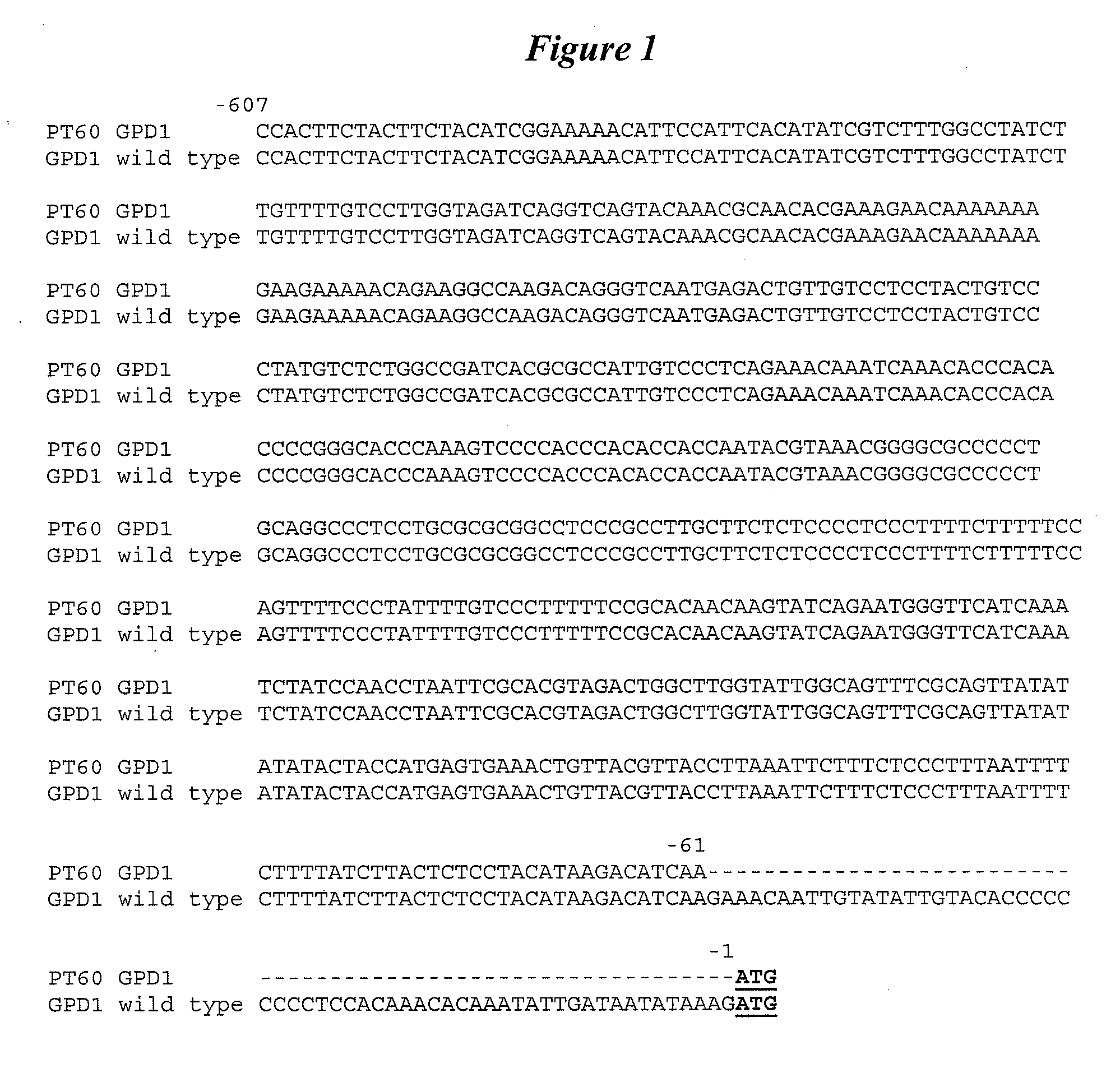Yeast having improved ethanol yield
a technology of haploid yeast and ethanol, which is applied in the field of genetically altered haploid yeast cells, can solve the problems of limited fossil fuels, and achieve the effects of reducing the activity or expression of fps1, and reducing the activity or expression of glycerol-3-phospha
- Summary
- Abstract
- Description
- Claims
- Application Information
AI Technical Summary
Benefits of technology
Problems solved by technology
Method used
Image
Examples
example 1
Construction of a / αfps1::URA3 PGKp-GLT1 gpd2::ura3
[0044]The a / αfps1::URA3 PGKp-GLT1 gpd2::ura3 strain used in the present invention was derived from a YC-DM yeast strain.
[0045]Construction of a selectable marker-recoverable gene knockout cassette: For multi-round gene manipulation, we made a URA3 based gene knockout cassette, in which, the URA3 gene can be used repeatedly as a selectable marker for multiple gene manipulation. To this end, plasmid pUC18-RYUR was constructed. First, a 435 bp DNA fragment corresponding to nucleotide sequence 4165652 bp to 4166066 of B. subtilis 168 genome were PCR amplified with primers Rep1-U (5′-GGG CCC GGA TCC GAG CAG CAT AAA CGA CTG CT-3′; SEQ ID NO:3) and Rep1-D (5′-GGG CCC TCT AGA ACG CTC AAT GTT GTT CAT GA-3′; SEQ ID NO:4) flanked by the restriction sites BamHI and XbaI, respectively. The resulting PCR product was digested by BamHI and XbaI and then ligated with the same enzyme pair digested pUC18, resulting in plasmid pUC18-R.
[0046]Second, the ...
example 2
Construction of Mata fps1::URA3 PGKp-GLT1 gpd2::ura3 PT60-GPD1
[0052]The a Mata fps1::URA3 PGKp-GLT1 gpd2::ura3 PT60-GPD1 strain used in the present invention was derived from a YC-DM yeast strain.
[0053]Mata fps1:: URA3 PGKp-GLT1 gpd2::ura3 PT60-GPD1 was constructed using the same procedures outlined in Example 1 for the construction of a / αfps1::URA3 PGKp-GLT1 gpd2::ura3, except that GPD1 was not deleted in the construction of Mata fps1::URA3 PGKp-GLT1 gpd2::ura3 PT60-GPD1. Instead, in the construction of Mata fps1:: URA3 PGKp-GLT1 gpd2::ura3 PT60-GPD1, the wild type GPD1 promoter was replaced with a truncated GPD1 promoter (−607 to −61). The replacement of the wild type GPD1 with PT60-GPD1 is discussed herein.
[0054]Replacement of the wild type GPD1 with PT60-GPD1: First, the truncated GPD1 promoter (−607 to −61) was amplified from yeast genomic DNA using primer pairs pGPD1-U (5′ gggcccGAATTCcacttctacttctacatcg3′; SEQ ID NO:19), containing the restriction site for EcoRI and nucleotid...
example 3
Ethanol and Glycerol Yields of Mata fps1::URA3 PGKp-GLT1 gpd2::ura3 PT60-GPD1 as Compared to Other Commercially Available Yeast Cells and a / αfps1::URA3 PGKp-GLT1 gpd2::ura3
[0066]Corn mash was prepared at ˜32.6% sugars with 31.13% solids as measured by a microwave moisture analyzer. Standard preparation of the corn mash was completed using freshly ground corn and Alpha-amylase enzyme. The approximate Brix of the material was 26.0 and the starting pH of the corn mash was 4.8. A total of 500 ppm of Nitrogen (270 ppm from Ammonia and 230 ppm N from urea) along with 5 ppm of each of the following antibiotics, Allpen and Lactoside V were put into the corn mash prior to inoculation with yeast. Thirty minutes prior to inoculation with yeast, glucoamylase was added to the corn mash. Erlenmyer flasks (500 ml size) were used with needle traps for the experiment. Three hundred (300 g) grams of the above prepared corn mash was weighed into each flask. Triplicate flasks for each yeast strain were...
PUM
| Property | Measurement | Unit |
|---|---|---|
| Density | aaaaa | aaaaa |
| Density | aaaaa | aaaaa |
| Density | aaaaa | aaaaa |
Abstract
Description
Claims
Application Information
 Login to View More
Login to View More - R&D Engineer
- R&D Manager
- IP Professional
- Industry Leading Data Capabilities
- Powerful AI technology
- Patent DNA Extraction
Browse by: Latest US Patents, China's latest patents, Technical Efficacy Thesaurus, Application Domain, Technology Topic, Popular Technical Reports.
© 2024 PatSnap. All rights reserved.Legal|Privacy policy|Modern Slavery Act Transparency Statement|Sitemap|About US| Contact US: help@patsnap.com








